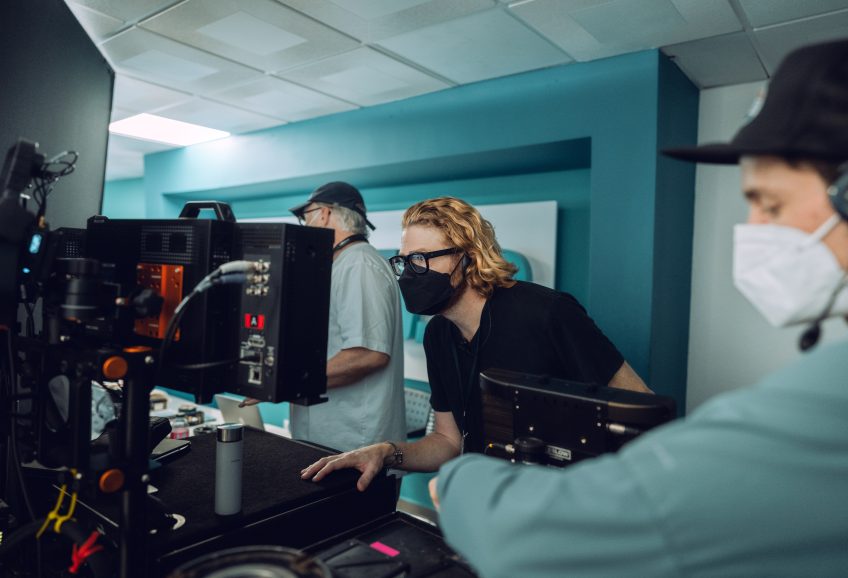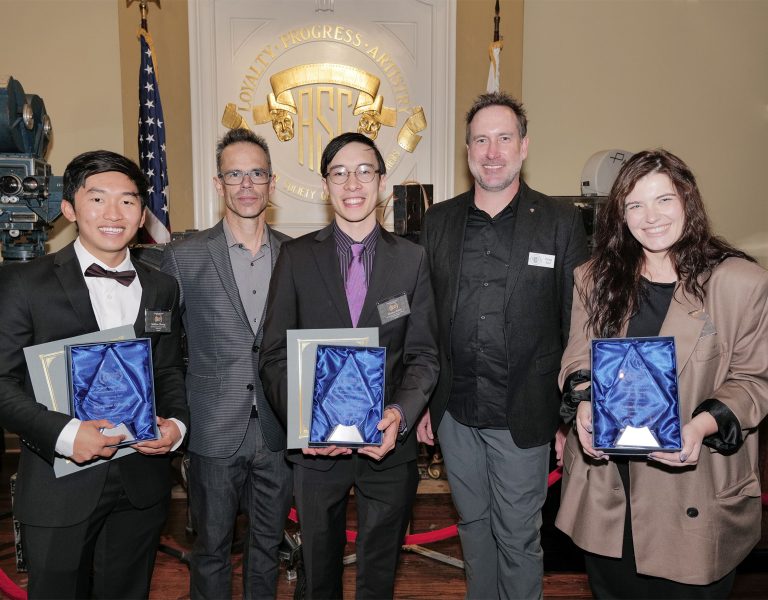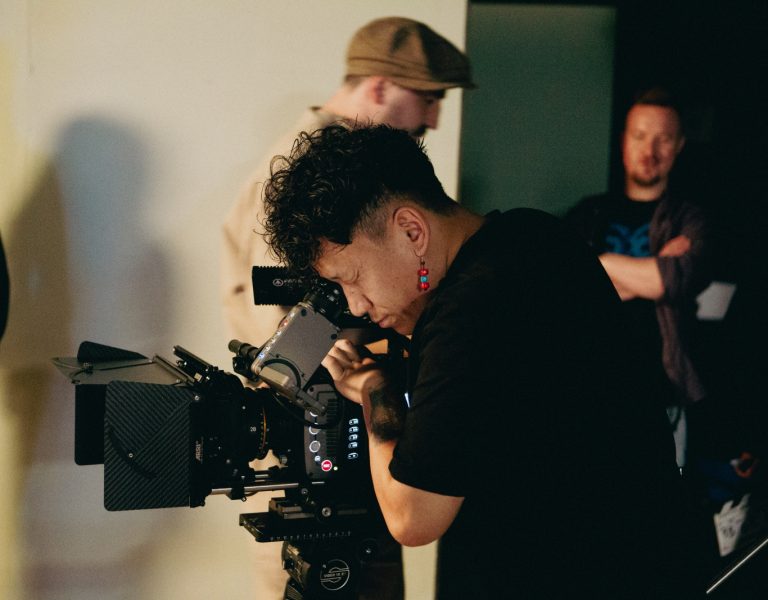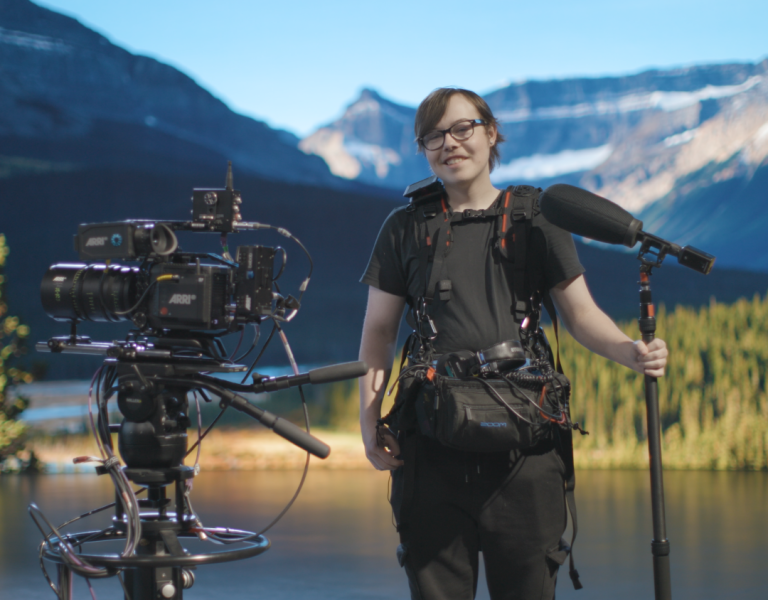Home » Features » Opinion » Across The Pond »
Though the labour disputes may have come to a close – for now – their reverberations still echo around Hollywood, as Mark London Williams sees first-hand on a food drive with IATSE in Los Angeles. We also bid a sad farewell to an accomplished cinematographer and former Academy president, and hear from the visual artists behind The Killer and Five Nights at Freddy’s.
You’re not alone in feeling it’s essentially impossible to keep up with “the news”, on either side of the pond, and the world surrounding it. And most of it these days feels not particularly welcome (though, hey! Strike settlement! Ahead, at least, of next year’s other expiring Hollywood contracts…).
And so it was, as we sat down to compose this latticework of a column, an email from the Academy popped up to announce that John Bailey ASC had passed away. Bailey, of course, was Academy president for a couple of years ahead of the pandemic. The first cinematographer to be one (unless we count George Stevens’ pre-directing work, some 70 years earlier), and only the second “crew member” to hold the office, he was also an ASC lifetime achievement recipient, and renowned for his work on films like Groundhog Day and The Big Chill, arthouse fare like Swimming to Cambodia, and many others.
We last talked to John around the time Francis Ford Coppola’s re-edited third and final Godfather film was being released on Blu-Ray, for a remembrance of the late, great Gordon Willis ASC, who shot all three iconic instalments.
Willis, he said, was one of those who made the world at large consider “the cinematographer as visual auteur. Aside from John Alton (“the king of noir,” he’d called him earlier) and a few other people – even the great DPs, like James Wong Howe ASC, William H. Daniels ASC, Karl Struss ASC – people we think of as being distinctive – they were very reluctant to talk about themselves as artists in the way that Vittorio (Storaro ASC AIC) does.
“Without saying ‘I’m an artist,’ Gordy, in his maverick masculinity – a brilliant guy’s guy – he just demonstrated he was an artist. He had a vision about how he worked, and had a vision and (did it).”
And so, another “soldier in the trenches”, as Bailey once described himself in conversation at an Oscar event (though remarking he’d become “a general” with ascendency to the Academy presidency, after years as one of its governors) has made his own inevitable crossing over that particular battlefield-cum-dance floor that we all dwell on. And one more witness to the art form’s history – and occasional practitioner of it – is now quiet. Rest easy, Mr. Bailey.

Epochal endeavour
As for that bit of good news, that the epic – or perhaps epochal – Hollywood strikes have now come to end, with the agreement between the AMPTP and SAG-AFTRA, that too cropped up as an alert, between heading out of one Netflix screening (Maestro) and over to another (May December), which somehow felt like a most Hollywood way to find out a tentative agreement had been reached. (And more about those two films in upcoming columns!)
The next day, while running errands – L.A. being L.A. – the local radio news carried the press conference featuring SAG-AFTRA president Fran Drescher, and chief negotiator Duncan Crabtree-Ireland, so that it was possible to be getting groceries, petrol, and more specific details about the settlement, all at once.
There are likely several columns’ worth of analysis to be had about what seems like a pretty good deal in getting thespian hands into new “pockets” of revenue – formerly reserved only for the studios and streamers themselves – as Drescher kept calling them. And you will have doubtless read some of them already.
For our purposes, focusing primarily on the craft and crew side, what might the SAG agreement mean when IATSE’s contract expires next year? (Yes, already!)
Both Drescher and Crabtree-Ireland praised the “unbelievable solidarity” and support they got from the other guilds, including Hollywood’s Teamsters (also with an expiring contract in ‘24), and said they looked forward to “rallying” with them in the months ahead.
They also touted the AI protections afforded actors, saying there must now be informed consent, and upfront compensation for the replication of actors’ likenesses, and that even background actors – in addition to a pay raise! – will have protection not only against their AI duplicates being used, but even against studios’ attempting to reduce the contractual number of extras with digital versions.
Though that presumably leaves the question of how many flesh-and-blood extras will then be contractually specified.
As Drescher noted, “in a synthetic world, you don’t need hair and makeup people, you don’t need drivers, you don’t need set-builders,” all of which is true enough. But this contract doesn’t necessarily offer protection to set-builders, or anyone else working on any aspect of production not directly involved with being an actor, or getting them suited up.
You might not need a lot of greens-crew, script supervisors, sound mixers, or gaffers or grips either (if more of your lighting can be rendered) once AI becomes more adept at those, and other filmic chores.
So how IATSE tackles those protections for their membership, cinematographers included, now that writers have laid down their swords and once again picked up pens – and actors have followed suit – all remains to be seen, in what already promises to be an overly interesting year ahead.

Playing a part
Just as it remains to be seen how long production will actually ramp back up to some resemblance of what it was, pre-strike (to say nothing of, pre-pandemic). A couple of weeks ahead of the settlement, at IATSE’s invitation, we visited one of the periodic food drives the IA has set up, along with the local Teamsters. This one was held, fittingly, at the Our Lady of Perpetual Help Church, in Santa Clarita, one of the nearby, once-affordable suburbs of L.A.
There were boxes, bags, and cans of rice, beans, fruit, vegetables, frozen hams and chicken, and other items like nappies nappies (or diapers, depending on your side of the Atlantic) and detergent for those who might need it, being passed through car windows – many of them late-model – as people slowly rolled through. WGA and SAG-AFTRA members were pitching in to help distribute the wares, most of those made possible by Labour Community Services, a not-for-profit partner of the LA Federation of Labour, overseen by its director Armando Olivas, who was there pitching in himself.
He mentioned a great need for such help not just among dispossessed showbiz workers, but other unions (such as striking hotel workers, and those affected by the recent United Auto Workers strikes) while also emphasising a lot of their programmes and drives weren’t just for “labour” or union workers specifically, but also the community.
He also mentioned upcoming turkey and toy giveaways, as it would seem likely that many of the same families who’d been out of work since the strikes began, wouldn’t see any until the new year at the earliest, and the “need” will continue, perhaps more acutely, during the holidays.

Indeed, one location manager we spoke to, Jason McCauley, said this was “the longest I’d been out of work since college”, and also figured that the “weeks of prep” that start the employment clock ticking on film productions, or TV seasons, wouldn’t begin in earnest until after the new year.
Meanwhile, aside from helping to pass out food and goods, he would also avail himself of them as well, even on behalf of union members who might balk at taking what they deem as “charity”.
He would often find himself “cooking for others, (including) union members”, thereby keeping some sense of cohesion intact among crew folk and their families, with large communal meals.

Meeting of minds
Of course, at this time of year, and through the rest of winter, one of the most common types of “communal” gatherings in Hollywood is the series of For Your Consideration events, eventually culminating in nominations and the award shows themselves.
Netflix hosted a screening at the Academy Museum for one of its own hoped-for contenders, The Killer, David Fincher’s film about a ruthless-yet-philosophical hitman-on-a-mission, played by Michael Fassbender.
Fassbender could be angling for a best acting nod here, though one also wonders – speaking of the tenor of the times – about the role of the “cold-blooded yet intriguingly philosophical hitman” genre itself, so adeptly brought to fruition by Quentin Tarantino, in an age where the horrors of ongoing, actual violence surround us daily.
Such conundrums aside, it’s quite crisply done, constructed from what Fincher described after as a “rigorously subjective perspective,” with sterling credits above and below the line, including award nominees like sound designer Ren Klyce, and the cinematography of Erik Messerschmidt ASC, who previously won an Oscar, ASC and BSC award with Fincher for his work on the also-Netflix produced Mank.

There was a panel after the film and a reception after that in what the Museum calls its “Tea Room” though after having been to a handful of events there, this reporter has yet to actually have tea in it. There were no actors available though – no Fassbender or Tilda Swinton or anyone else – since SAG hadn’t settled at that point.
We caught up with Messerschmidt afterwards, though not so much for a formal interview (that will likely come next month, after Ferrari, since he is once again competing against himself with end-of-year releases). Finding him out under the night lights on the tea room patio, with a few people already queued up to chat with him, we asked – after our first live introduction – if, after multiple projects with the director (including the series Mindhunter), he and Fincher had developed a kind of working shorthand.
Given Fincher’s “rigorous perspective” comment earlier, and what might termed a somewhat unrelentless directorial style, it was a surprise to hear that he could also be somewhat given to an improvisatory approach on set, that, if not quite Robert Altman-like in scope, seemed to allow not only actors to find their moves within a set, but also to allow Messerschmidt to discover shots, as well.

Though speaking of rigour, there was also talk about the influences of Hitchcock, visually and procedurally – a rather polar opposite approach to Altman’s – and we also asked what he used to capture both the literally and thematically dark story (“[Shooting is] a lot easier in the dark because you don’t have to light,” he’d said earlier on the panel). Messerschmidt mentioned not only the RED Raptor, but the somewhat “dreamy” look the glass gave him as well. In this case, Leitz Summilux-Cs along with some Fujinon Premiers.
The journey charts Fassbender’s titular character trying to, well, rigorously (that word again!), almost fastidiously, stay in control of his world, all while on a particular mission of vengeance. The payoff comes with the film’s final line, in which his entire philosophical relationship to that world, and his life (and perhaps, ours as viewers?) is jarringly reassessed.

Thrills and kills
As for worlds spinning out of control, or at least the veils between them becoming a lot thinner, that of course is one of the hallmarks of our recently concluded Halloween season (or, given all that still haunts the world, does it ever really “conclude?”) One of October’s box office surprises was Five Nights at Freddy’s, based on the cult favourite video game franchise of the same name, which in turn was based on animatronic-heavy “family entertainment” centres like the Chuck E. Cheese chain, where your correspondent logged his share of hours as a younger father, and who now wonders why someone hadn’t understood the whole enterprise’s potential for horror even earlier.
Cinematographer Lyn Moncrief captures the creepiness in the ostensibly abandoned pizza and fun centre, as, of course, the animatronics themselves don’t let the mere absence of living customers keep them from springing back to life.
Moncrief himself was familiar with all those “family” animatronics – at Chuck E. Cheese’s and elsewhere – from his own ‘70s and ‘80s childhood, but when he mentioned the project to his nine year-old daughter, she “was instantly ‘what are you doing!?’ She became super obsessed. It was really nice to have a kid while prepping this,” giving him new insight to the effects of the game itself on its players, and part of the film’s putative audience.
He mentioned that part of the game’s “success [was] a very first-person element,” which helped inform the visuals he devised with director Emma Tammi, with whom he was doing a fourth movie, having begun with the IFC Midnight horror-western The Wind.

“We had built a good working relationship,” he says, and “she’d asked me if I would shoot it. I’ve worked with a few directors a few times [but] she’s the director I’ve worked with the most so far.”
He also mentions, à la Mr. Messerschmidt, that “when you have a good rapport with a director – and you’ve gotten through a project or two together” then you can trust each other to be more “playful” in discovering visual aspects.
The playfulness and spookiness was captured on anamorphic glass, moving from favoured Cooke Anamorphics on previous projects to “Arri DNAs. We like those lenses because even though they’re spherical they have anamorphic qualities that we responded to aesthetically [and we] wanted to find a spherical option for Five Nights since we’d be shooting on a 2.1 aspect ratio,” with Alexa 65s, and a Mini on a Steadicam. “Emma’s a director who likes to shoot wide and close with her subjects,” a particularly helpful approach when that subject is something unnerving like an animatronic creature springing to life.
Meanwhile, with the film’s surprise box office returns, he’s hoping that “[Emma gets] some things,” which may in turn lead to some new projects for Moncrief.
The actors hadn’t settled yet when we talked, and he described a bit of “PTSD, like our COVID time” after the wrap, as everyone waited for work. But with the positive audience response, he said it was “fingers crossed” for the road ahead.
Which is probably how most of us are going through our lives these days.
See you for our 2023 finale, deeper into the holidays. @TricksterInk / AcrossthePondBC@gmail.com

















